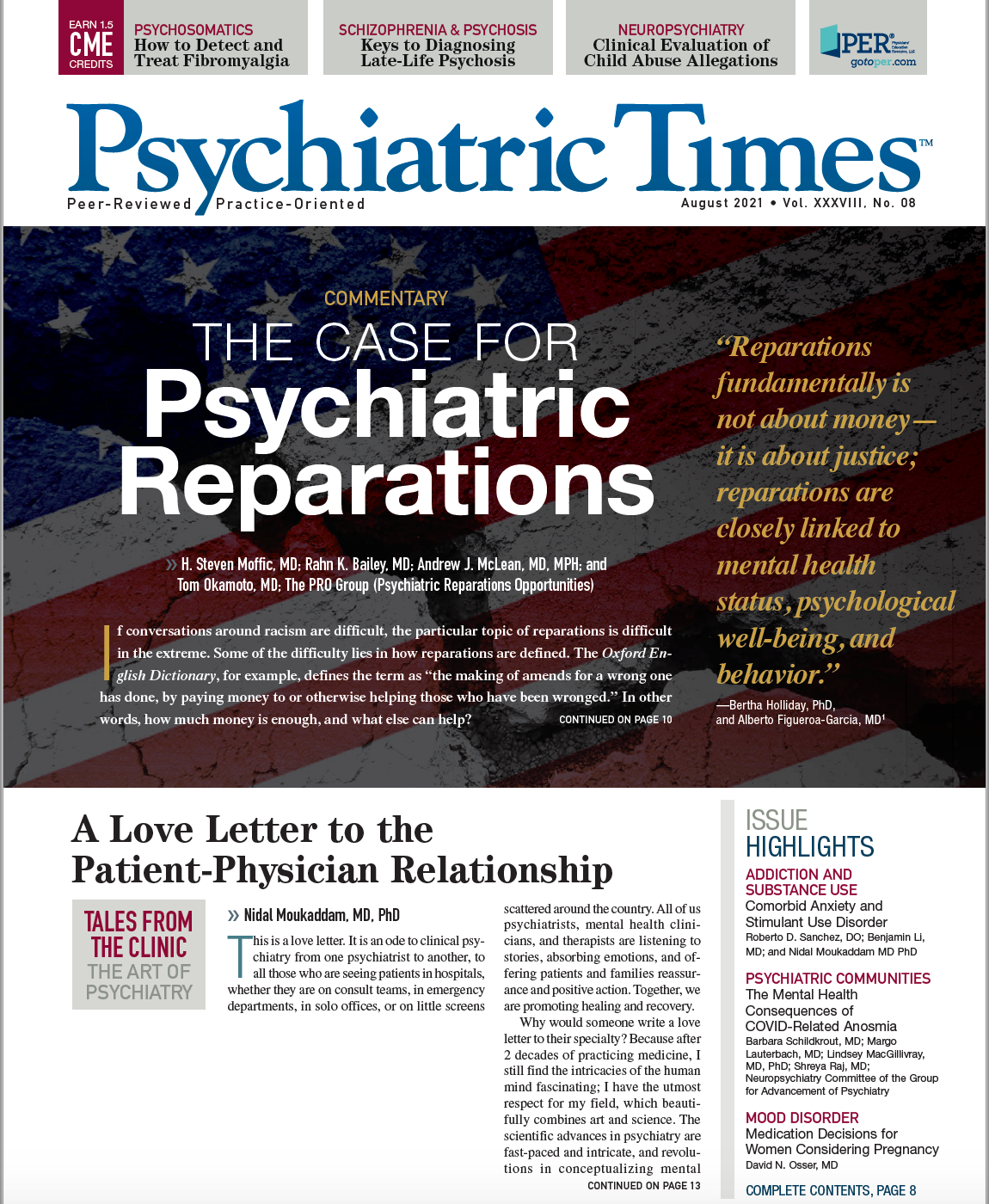More In This Series
Roberto D. Sanchez, DO; Benjamin Li, MD; Nidal Moukaddam, MD, PhD
Hai Le, MD; Sawsan Khan, MD
What can be done to strengthen the therapeutic alliance?
Monkey Business/AdobeStock

TALES FROM THE CLINIC
This is a love letter. It is an ode to clinical psychiatry from one psychiatrist to another, to all those who are seeing patients in hospitals, whether they are on consult teams, in emergency departments, in solo offices, or on little screens scattered around the country. All of us psychiatrists, mental health clinicians, and therapists are listening to stories, absorbing emotions, and offering patients and families reassurance and positive action. Together, we are promoting healing and recovery.
Why would someone write a love letter to their specialty? Because after 2 decades of practicing medicine, I still find the intricacies of the human mind fascinating; I have the utmost respect for my field, which beautifully combines art and science. The scientific advances in psychiatry are fast-paced and intricate, and revolutions in conceptualizing mental illnesses are afoot. Yet, none of these advances or treatments can be meaningfully implemented without a thorough history-taking, an understanding of the patient’s environment and family dynamics, and an assessment of their insight into symptoms and their willingness to engage in treatment. Most importantly, none can be implemented without the trust and connectedness that occur in a healthy patient-physician relationship.
Roberto D. Sanchez, DO; Benjamin Li, MD; Nidal Moukaddam, MD, PhD
Hai Le, MD; Sawsan Khan, MD
The Art of Medical Conversation
The art of psychiatry goes back to the patient-physician relationship, the basic building block of medicine, as it has been for millennia. That relationship has evolved, of course, reflecting changes in our understanding of disease, wellness, and the roles of patients and physicians. Over the centuries, the physician has been transformed from a healer with quasi-magical powers to a partner in wellness and recovery. This evolution has been obvious through history, but only recently has scientific attention turned to what, exactly, physicians are doing that is so impactful.
In his seminal 1932 work, The Doctor, His Patient, and the Illness, Michael Balint, MD, PhD,1 coined the concept of the doctor as drug. He highlighted the importance of therapeutic interaction, calling it vital to treatment while acknowledging that the dose of this treatment—the required number of visits and the duration of visits—was not clear. Later literature developed new terminology. Mainstream medicine labeled it the “patient-physician relationship,” whereas the psychiatric field would call it nonspecific factors. Regardless of terminology, it is the je ne sais quoi that takes place in the intimacy of a real conversation between human beings.
What Happens When We Lose Touch
Up to 40% of deaths are attributable to modifiable behavioral factors (such as healthy eating, substance use, and physical activity).2,3 Whether or not patients modify these behaviors depends to a great extent on the level of trust they give to their physicians.4 Qualities such as availability, benevolence, compassion, competence, honesty, integrity, knowledge, reliability, respectfulness, sincerity, and understanding are cited as essential in fostering and maintaining a healthy patient-physician relationship.5
The realities of modern health care, however, are not matched to this paradigm of relationship growth, nor do they protect it. In recent decades, the foundations of clinical medicine/psychiatry have been under attack from the health care system itself. Visit lengths have sharply declined,6 as has the number of psychiatrists providing therapy.7 So the question must be raised: In a visit of 10 to 15 minutes, how much of a therapeutic alliance can actually be built? I fear our self-conception is changing, too. Words like provider, prescriber, and mental health specialist do not capture the centrality of the patient-physician relationship. We are at risk of losing the sense that, in the words of Hugh Crichton-Miller, MD, “The patient [is] not simply an object but a person, needing enlightenment and reassurance.”8
The health care system has been attempting to standardize aspects of the patient-physician relationship that could promote success. Bias and countertransference are 2 aspects that have been studied in context of patient encounters,9-12 and it is recognized that concordance in the patient-physician relationship is a desirable asset for successful treatment alliances.13,14 Achieving that concordance in short, sparse clinical visits may not be achievable, but the operationalization of these concepts nevertheless leads to a better understanding of nonspecific factors in the patient-physician relationship.
When physicians and patients are unable to build strong relationships, patients fare worse. In the treatment of depression, the number of meetings with the therapist or physician, regardless of the therapeutic modality, affects outcomes, even when patients are being treated with psychotropic agents.15 The working alliance becomes even more important when addressing difficult issues of trauma and addiction.16 Recent advances inform us that nonspecific factors in treatment can be conceptualized in 2 areas: expectancy and alliance. These can be further subdivided into trait-like and state-like dimensions, each with their own neurobiological underpinnings.17 Trait-like components refer to attachment and personality styles, and they influence the relationship between the patient and the individual treating them in a nonspecific manner.15 When used optimally and at the right time, state-like dimensions can be used as active ingredients for change in therapy. Technological advances allow us to study the therapeutic alliance as it evolves session by session, taking into account within-person fluctuations and stable between-person differences.18
The therapeutic alliance is also crucial to overcoming mental health stigma. Individuals sometimes resent psychiatric labels, and some patients may be harassed for using mental health care. To bridge that gap, we resort to the art of psychiatry, the alliance in the patient-physician relationship that helps patients see their treatment as a means to achieve life goals and recovery.
Concluding Thoughts
The patient-physician relationship is what the upcoming Psychiatric TimesTM series, "Tales From The Clinic: The Art of Psychiatry," is all about. The cases discussed are fictional, but they represent common presentations. Moving from the case, the human story, we transition to the evidence-based application of psychiatric research, highlighting the complex interplay of art and science. As readers will note, some of the cases span years of treatment. Many patients will say that they never thought their improvements were possible, and that treatment has given them a new life. But progress is not possible without both art and science—the art of human rapport, and the science that brings us effective, precise treatments.
So, to all my fellow psychiatrists and therapists, this is a love letter to our wonderful field, where the magic of medicine is still alive. Your comments on these cases are welcome. Please send them to PTEditor@MMHGroup.com.
Dr Moukaddam is associate professor, Menninger Department of Psychiatry and Behavioral Sciences, Baylor College of Medicine, and Ben Taub Adult Outpatient Services director, medical director, Stabilization, Treatment & Rehabilitation (STAR) Program for Psychosis. She also serves on the Psychiatric TimesTM Advisory Board.
References
1. Balint M. The doctor, his patient, and the illness. The Lancet. 1955;265(6866):683-688.
2. Danaei G, Ding EL, Mozaffarian D, et al. The preventable causes of death in the United States: comparative risk assessment of dietary, lifestyle, and metabolic risk factors. PLoS Med. 2009;6(4):e1000058.
3. Mokdad AH, Marks JS, Stroup DF, Gerberding JL. Actual causes of death in the United States, 2000. JAMA. 2004;291(10):1238-1245.
4. Berry LL, Parish JT, Janakiraman R, et al. Patients’ commitment to their primary physician and why it matters. Ann Fam Med. 2008;6(1):6-13.
5. Grant SB. Are there blueprints for building a strong patient-physician relationship? Virtual Mentor. 2009;11(3):232-236.
6. Gottschalk A, Flocke SA. Time spent in face-to-face patient care and work outside the examination room. Ann Fam Med. 2005;3(6):488-493.
7. Olfson M, Marcus SC, Druss B, et al. National trends in the outpatient treatment of depression. JAMA. 2002;287(2):203-209.
8. Crichton-Miller H. The Doctor’s Personality: The Doctor’s Role in Society. Hogarth Press; 1932.
9. Dehon E, Weiss N, Jones J, et al. A systematic review of the impact of physician implicit racial bias on clinical decision making. Acad Emerg Med. 2017;24(8):895-904.
10. Dovidio JF, Penner LA, Albrecht TL, . Disparities and distrust: the implications of psychological processes for understanding racial disparities in health and health care. Soc Sci Med. 2008;67(3):478-486.
11. Hirsh AT, Hollingshead NA, Ashburn-Nardo L, Kroenke K. The interaction of patient race, provider bias, and clinical ambiguity on pain management decisions. J Pain. 2015;16(6):558-568.
12. Johnson TJ, Winger DG, Hickey RW, et al. Comparison of physician implicit racial bias toward adults versus children. Acad Pediatr. 2017;17(2):120-126.
13. Schinkel S, Schouten BC, Street RL Jr, et al. Enhancing health communication outcomes among ethnic minority patients: the effects of the match between participation preferences and perceptions and doctor-patient concordance. J Health Commun. 2016;21(12):1251-1259.
14. Street RL Jr, Gordon H, Haidet P. Physicians’ communication and perceptions of patients: is it how they look, how they talk, or is it just the doctor? Soc Sci Med. 2007;65(3):586-598.
15. Falkenström F, Josefsson A, Berggren T, Holmqvist R. How much therapy is enough? comparing dose-effect and good-enough models in two different settings. Psychotherapy (Chic). 2016;53(1):130-139.
16. Wang LP, Maxwell SE. On disaggregating between-person and within-person effects with longitudinal data using multilevel models. Psychol Methods. 2015;20(1):63-83.
17. Zilcha-Mano S, Roose SP, Brown PJ, Rutherford BR. Not just nonspecific factors: the roles of alliance and expectancy in treatment, and their neurobiological underpinnings. Front Behav Neurosci. 2019;12:293.
18. Falkenström F, Solomonov N, Rubel J. Using time-lagged panel data analysis to study mechanisms of change in psychotherapy research: methodological recommendations. Couns Psychother Res. 2020;20(3):435-441. ❒
